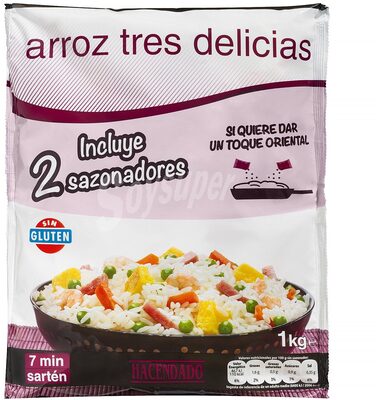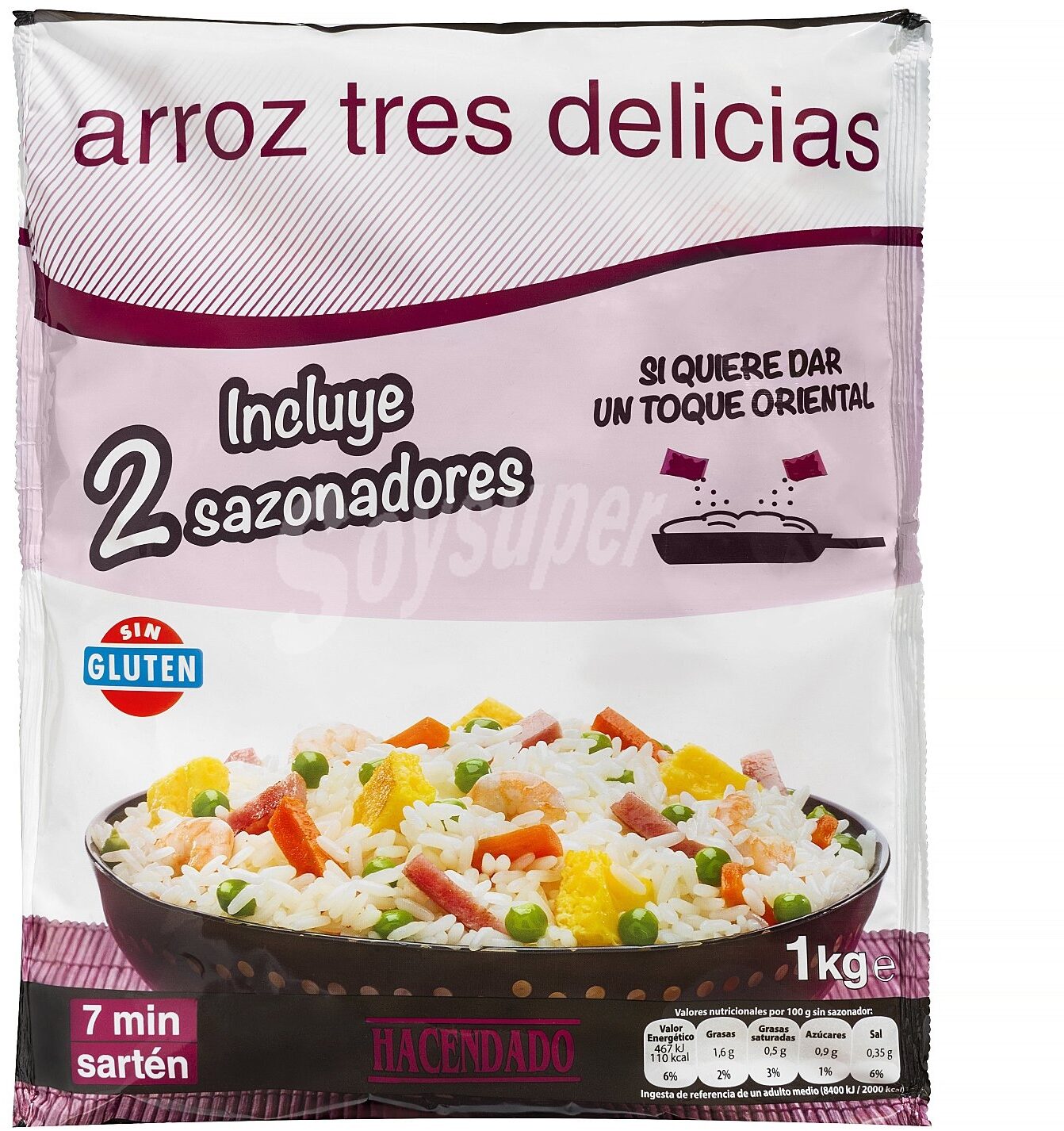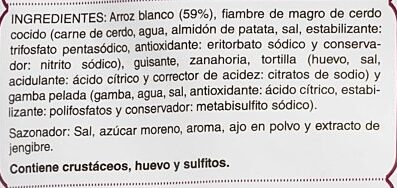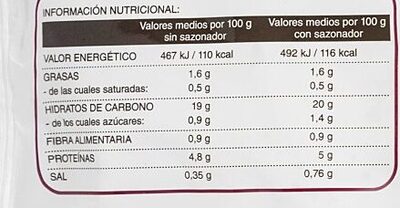Help us make food transparency the norm!
As a non-profit organization, we depend on your donations to continue informing consumers around the world about what they eat.
The food revolution starts with you!
Arroz tres delicias - Hacendado
Arroz tres delicias - Hacendado
This product page is not complete. You can help to complete it by editing it and adding more data from the photos we have, or by taking more photos using the app for Android or iPhone/iPad. Thank you!
×
Barra-kodea: 8480000613417 (EAN / EAN-13)
Markak: Hacendado
Kategoriak: en:Plant-based foods and beverages, en:Plant-based foods, en:Cereals and potatoes, en:Seeds, en:Cereals and their products, en:Frozen foods, en:Meals, en:Cereal grains, en:Frozen plant-based foods, en:Rices, fr:Céréales préparées, en:Frozen cereals, en:Prepared rices, en:Frozen pre-cooked rice
Etiketak, ziurtagiriak, sariak: en:No gluten
Dendak: Mercadona
Saltzen diren herrialdeak: Espainia
Matching with your preferences
Health
Osagaiak
-
37 ingredients
: Arroz blanco (59%), fiambre de magro de cerdo cocido (carne de cerdo, agua, almidón de patata, sal, estabilizante: trifostato pentasódico, antioxidante: eritorbato sódico y conservador: nitrito sódico), guisante, zanahoria, tortilla (huevo, sal, acidulante: ácido cítrico y corrector de acidez: citratos de sodio) y gamba pelada (gamba, agua, sal, antioxidante: ácido cítrico, estabilizante: polifosfatos y conservador: metabisulfito sódico), Sazonador: Sal, azúcar moreno, aroma, ajo en polvo y extracto de jengibre, Contiene crustáceos, huevo y sulfitosAlergenoak: en:Crustaceans, en:Eggs, en:Sulphur dioxide and sulphites
Food processing
-
Ultra processed foods
Elements that indicate the product is in the 4 - Ultra prozesatutako elikagaiak eta edariak group:
- Gehigarria: E452
- Osagaia: Flavouring
Food products are classified into 4 groups according to their degree of processing:
- Prozesatu gabeko edo ahalik eta gutxien prozesatutako elikagaiak
- Sukaldaritzako osagaiak prozesatu
- Prozesatutako jakiak
- Ultra processed foods
The determination of the group is based on the category of the product and on the ingredients it contains.
Gehigarriak
-
E223
Sodium metabisulfite: Sodium metabisulfite or sodium pyrosulfite -IUPAC spelling; Br. E. sodium metabisulphite or sodium pyrosulphite- is an inorganic compound of chemical formula Na2S2O5. The substance is sometimes referred to as disodium metabisulfite. It is used as a disinfectant, antioxidant, and preservative agent.Source: Wikipedia (Ingeles)
-
E250
Sodium nitrite: Sodium nitrite is the inorganic compound with the chemical formula NaNO2. It is a white to slightly yellowish crystalline powder that is very soluble in water and is hygroscopic. It is a useful precursor to a variety of organic compounds, such as pharmaceuticals, dyes, and pesticides, but it is probably best known as a food additive to prevent botulism. It is on the World Health Organization's List of Essential Medicines, the most important medications needed in a basic health system.Nitrate or nitrite -ingested- under conditions that result in endogenous nitrosation has been classified as "probably carcinogenic to humans" by International Agency for Research on Cancer -IARC-.Source: Wikipedia (Ingeles)
-
E316
Sodium erythorbate: Sodium erythorbate -C6H7NaO6- is a food additive used predominantly in meats, poultry, and soft drinks. Chemically, it is the sodium salt of erythorbic acid. When used in processed meat such as hot dogs and beef sticks, it increases the rate at which nitrite reduces to nitric oxide, thus facilitating a faster cure and retaining the pink coloring. As an antioxidant structurally related to vitamin C, it helps improve flavor stability and prevents the formation of carcinogenic nitrosamines. When used as a food additive, its E number is E316. The use of erythorbic acid and sodium erythorbate as a food preservative has increased greatly since the U.S. Food and Drug Administration banned the use of sulfites as preservatives in foods intended to be eaten fresh -such as ingredients for fresh salads- and as food processors have responded to the fact that some people are allergic to sulfites. It can also be found in bologna, and is occasionally used in beverages, baked goods, and potato salad.Sodium erythorbate is produced from sugars derived from different sources, such as beets, sugar cane, and corn. An urban myth claims that sodium erythorbate is made from ground earthworms; however, there is no truth to the myth. It is thought that the genesis of the legend comes from the similarity of the chemical name to the words earthworm and bait.Alternative applications include the development of additives that could be utilized as anti-oxidants in general. For instance, this substance has been implemented in the development of corrosion inhibitors for metals and it has been implemented in active packaging.Sodium erythorbate is soluble in water. The pH of the aqueous solution of the sodium salt is between 5 and 6. A 10% solution, made from commercial grade sodium erythorbate, may have a pH of 7.2 to 7.9. In its dry, crystalline state it is nonreactive. But, when in solution with water it readily reacts with atmospheric oxygen and other oxidizing agents, which makes it a valuable antioxidant.Source: Wikipedia (Ingeles)
-
E330 - Azido zitriko
Citric acid: Citric acid is a weak organic acid that has the chemical formula C6H8O7. It occurs naturally in citrus fruits. In biochemistry, it is an intermediate in the citric acid cycle, which occurs in the metabolism of all aerobic organisms. More than a million tons of citric acid are manufactured every year. It is used widely as an acidifier, as a flavoring and chelating agent.A citrate is a derivative of citric acid; that is, the salts, esters, and the polyatomic anion found in solution. An example of the former, a salt is trisodium citrate; an ester is triethyl citrate. When part of a salt, the formula of the citrate ion is written as C6H5O3−7 or C3H5O-COO-3−3.Source: Wikipedia (Ingeles)
-
E331
Sodium citrate: Sodium citrate may refer to any of the sodium salts of citrate -though most commonly the third-: Monosodium citrate Disodium citrate Trisodium citrateThe three forms of the salt are collectively known by the E number E331. Sodium citrates are used as acidity regulators in food and drinks, and also as emulsifiers for oils. They enable cheeses to melt without becoming greasy.Source: Wikipedia (Ingeles)
Ingredients analysis
-
en:Palm oil free
No ingredients containing palm oil detected
Unrecognized ingredients: es:fiambre-de-magro-de-cerdo-cocido, es:trifostato-pentasodicoSome ingredients could not be recognized.
We need your help!
You can help us recognize more ingredients and better analyze the list of ingredients for this product and others:
- Edit this product page to correct spelling mistakes in the ingredients list, and/or to remove ingredients in other languages and sentences that are not related to the ingredients.
- Add new entries, synonyms or translations to our multilingual lists of ingredients, ingredient processing methods, and labels.
If you would like to help, join the #ingredients channel on our Slack discussion space and/or learn about ingredients analysis on our wiki. Thank you!
-
en:Non-vegan
Non-vegan ingredients: en:Pork meat, Arrautza, Izkira, IzkiraSome ingredients could not be recognized.
We need your help!
You can help us recognize more ingredients and better analyze the list of ingredients for this product and others:
- Edit this product page to correct spelling mistakes in the ingredients list, and/or to remove ingredients in other languages and sentences that are not related to the ingredients.
- Add new entries, synonyms or translations to our multilingual lists of ingredients, ingredient processing methods, and labels.
If you would like to help, join the #ingredients channel on our Slack discussion space and/or learn about ingredients analysis on our wiki. Thank you!
-
en:Non-vegetarian
Non-vegetarian ingredients: en:Pork meat, Izkira, IzkiraSome ingredients could not be recognized.
We need your help!
You can help us recognize more ingredients and better analyze the list of ingredients for this product and others:
- Edit this product page to correct spelling mistakes in the ingredients list, and/or to remove ingredients in other languages and sentences that are not related to the ingredients.
- Add new entries, synonyms or translations to our multilingual lists of ingredients, ingredient processing methods, and labels.
If you would like to help, join the #ingredients channel on our Slack discussion space and/or learn about ingredients analysis on our wiki. Thank you!
-
Details of the analysis of the ingredients
We need your help!
Some ingredients could not be recognized.
We need your help!
You can help us recognize more ingredients and better analyze the list of ingredients for this product and others:
- Edit this product page to correct spelling mistakes in the ingredients list, and/or to remove ingredients in other languages and sentences that are not related to the ingredients.
- Add new entries, synonyms or translations to our multilingual lists of ingredients, ingredient processing methods, and labels.
If you would like to help, join the #ingredients channel on our Slack discussion space and/or learn about ingredients analysis on our wiki. Thank you!
: Arroz blanco 59%, fiambre de magro de cerdo cocido (carne de cerdo, agua, almidón de patata, sal, estabilizante (trifostato pentasódico), antioxidante (eritorbato sódico, conservador), nitrito sódico), guisante, zanahoria, tortilla (huevo, sal, acidulante (ácido cítrico, corrector de acidez), citratos de sodio), gamba (gamba, agua, sal, antioxidante (ácido cítrico), estabilizante (polifosfatos, conservador), metabisulfito sódico), Sazonador (Sal), azúcar moreno, aroma, ajo, jengibre- Arroz blanco -> en:white-rice - vegan: yes - vegetarian: yes - ciqual_food_code: 9100 - percent_min: 59 - percent: 59 - percent_max: 59
- fiambre de magro de cerdo cocido -> es:fiambre-de-magro-de-cerdo-cocido - percent_min: 4.1 - percent_max: 41
- carne de cerdo -> en:pork-meat - vegan: no - vegetarian: no - ciqual_proxy_food_code: 28205 - percent_min: 0.585714285714286 - percent_max: 41
- agua -> en:water - vegan: yes - vegetarian: yes - ciqual_food_code: 18066 - percent_min: 0 - percent_max: 20.5
- almidón de patata -> en:potato-starch - vegan: yes - vegetarian: yes - ciqual_proxy_food_code: 9510 - percent_min: 0 - percent_max: 13.6666666666667
- sal -> en:salt - vegan: yes - vegetarian: yes - ciqual_food_code: 11058 - percent_min: 0 - percent_max: 0.8
- estabilizante -> en:stabiliser - percent_min: 0 - percent_max: 0.8
- trifostato pentasódico -> es:trifostato-pentasodico - percent_min: 0 - percent_max: 0.8
- antioxidante -> en:antioxidant - percent_min: 0 - percent_max: 0.8
- eritorbato sódico -> en:e316 - vegan: yes - vegetarian: yes - percent_min: 0 - percent_max: 0.8
- conservador -> en:preservative - percent_min: 0 - percent_max: 0.4
- nitrito sódico -> en:e250 - vegan: yes - vegetarian: yes - percent_min: 0 - percent_max: 0.8
- guisante -> en:pea - vegan: yes - vegetarian: yes - percent_min: 0 - percent_max: 33.3333333333333
- zanahoria -> en:carrot - vegan: yes - vegetarian: yes - ciqual_food_code: 20009 - percent_min: 0 - percent_max: 18.45
- tortilla -> en:omelette - percent_min: 0 - percent_max: 12.3
- huevo -> en:egg - vegan: no - vegetarian: yes - ciqual_food_code: 22000 - percent_min: 0 - percent_max: 12.3
- sal -> en:salt - vegan: yes - vegetarian: yes - ciqual_food_code: 11058 - percent_min: 0 - percent_max: 0.8
- acidulante -> en:acid - percent_min: 0 - percent_max: 0.8
- ácido cítrico -> en:e330 - vegan: yes - vegetarian: yes - percent_min: 0 - percent_max: 0.8
- corrector de acidez -> en:acidity-regulator - percent_min: 0 - percent_max: 0.4
- citratos de sodio -> en:e331 - vegan: yes - vegetarian: yes - percent_min: 0 - percent_max: 0.8
- gamba -> en:shrimp - vegan: no - vegetarian: no - ciqual_food_code: 10021 - percent_min: 0 - percent_max: 9.225
- gamba -> en:shrimp - vegan: no - vegetarian: no - ciqual_food_code: 10021 - percent_min: 0 - percent_max: 9.225
- agua -> en:water - vegan: yes - vegetarian: yes - ciqual_food_code: 18066 - percent_min: 0 - percent_max: 4.6125
- sal -> en:salt - vegan: yes - vegetarian: yes - ciqual_food_code: 11058 - percent_min: 0 - percent_max: 0.8
- antioxidante -> en:antioxidant - percent_min: 0 - percent_max: 0.8
- ácido cítrico -> en:e330 - vegan: yes - vegetarian: yes - percent_min: 0 - percent_max: 0.8
- estabilizante -> en:stabiliser - percent_min: 0 - percent_max: 0.8
- polifosfatos -> en:e452 - vegan: yes - vegetarian: yes - percent_min: 0 - percent_max: 0.8
- conservador -> en:preservative - percent_min: 0 - percent_max: 0.4
- metabisulfito sódico -> en:e223 - vegan: yes - vegetarian: yes - percent_min: 0 - percent_max: 0.8
- Sazonador -> en:coating - vegan: maybe - vegetarian: maybe - percent_min: 0 - percent_max: 0.8
- Sal -> en:salt - vegan: yes - vegetarian: yes - ciqual_food_code: 11058 - percent_min: 0 - percent_max: 0.8
- azúcar moreno -> en:brown-sugar - vegan: yes - vegetarian: yes - ciqual_food_code: 31017 - percent_min: 0 - percent_max: 0.8
- aroma -> en:flavouring - vegan: maybe - vegetarian: maybe - percent_min: 0 - percent_max: 0.8
- ajo -> en:garlic - vegan: yes - vegetarian: yes - ciqual_food_code: 11000 - percent_min: 0 - percent_max: 0.8
- jengibre -> en:ginger - vegan: yes - vegetarian: yes - ciqual_food_code: 11074 - percent_min: 0 - percent_max: 0.8
Elikadura
-
Good nutritional quality
⚠ ️Warning: the amount of fruits, vegetables and nuts is not specified on the label, it was estimated from the list of ingredients: 13This product is not considered a beverage for the calculation of the Nutri-Score.
Positive points: 3
- Proteinak: 3 / 5 (balioa: 5, rounded value: 5)
- Fiber: 0 / 5 (balioa: 0.9, rounded value: 0.9)
- Fruits, vegetables, nuts, and colza/walnut/olive oils: 0 / 5 (balioa: 13.8375, rounded value: 13.8)
Negative points: 4
- Energia: 1 / 10 (balioa: 611, rounded value: 611)
- Azukreak: 0 / 10 (balioa: 1.4, rounded value: 1.4)
- Gantz saturatua: 0 / 10 (balioa: 0.5, rounded value: 0.5)
- Sodioa: 3 / 10 (balioa: 320, rounded value: 320)
The points for proteins are counted because the negative points are less than 11.
Nutritional score: (4 - 3)
Nutri-Score:
-
Nutrient levels
-
Koipe in low quantity (1.6%)
What you need to know- A high consumption of fat, especially saturated fats, can raise cholesterol, which increases the risk of heart diseases.
Recommendation: Limit the consumption of fat and saturated fat- Choose products with lower fat and saturated fat content.
-
Gantz-azido ase in low quantity (0.5%)
What you need to know- A high consumption of fat, especially saturated fats, can raise cholesterol, which increases the risk of heart diseases.
Recommendation: Limit the consumption of fat and saturated fat- Choose products with lower fat and saturated fat content.
-
Azukre in low quantity (1.4%)
What you need to know- A high consumption of sugar can cause weight gain and tooth decay. It also augments the risk of type 2 diabetes and cardio-vascular diseases.
Recommendation: Limit the consumption of sugar and sugary drinks- Sugary drinks (such as sodas, fruit beverages, and fruit juices and nectars) should be limited as much as possible (no more than 1 glass a day).
- Choose products with lower sugar content and reduce the consumption of products with added sugars.
-
Gatz arrunt in moderate quantity (0.8%)
What you need to know- A high consumption of salt (or sodium) can cause raised blood pressure, which can increase the risk of heart disease and stroke.
- Many people who have high blood pressure do not know it, as there are often no symptoms.
- Most people consume too much salt (on average 9 to 12 grams per day), around twice the recommended maximum level of intake.
Recommendation: Limit the consumption of salt and salted food- Reduce the quantity of salt used when cooking, and don't salt again at the table.
- Limit the consumption of salty snacks and choose products with lower salt content.
-
-
Nutrition facts
Nutrition facts As sold
for 100 g / 100 mlCompared to: en:Frozen pre-cooked rice Energia 611 kj
(146 kcal)+% 10 Koipe 1,6 g -% 2 Gantz-azido ase 0,5 g +% 27 Carbohydrates 20 g -% 15 Azukre 1,4 g +% 141 Fiber 0,9 g -% 20 Proteina 5 g +% 18 Gatz arrunt 0,8 g +% 114 Fruits‚ vegetables‚ nuts and rapeseed‚ walnut and olive oils (estimate from ingredients list analysis) 13,838 %
Ingurumena
-
Eco-Score E - Very high environmental impact
The Eco-Score is an experimental score that summarizes the environmental impacts of food products.→ The Eco-Score was initially developped for France and it is being extended to other European countries. The Eco-Score formula is subject to change as it is regularly improved to make it more precise and better suited to each country.Life cycle analysis
-
Average impact of products of the same category: D (Score: 32/100)
Kategoria: Rice, parboiled, raw
Kategoria: Rice, parboiled, raw
- PEF environmental score: 0.98 (the lower the score, the lower the impact)
- including impact on climate change: 2.76 kg CO2 eq/kg of product
Stage Impact Agriculture
93.7 %Processing
0.0 %Ontziratzea
2.3 %Transportation
3.6 %Distribution
0.5 %Consumption
0.0 %
Bonuses and maluses
-
Missing origins of ingredients information
Malus: -5
⚠ ️ The origins of the ingredients of this product are not indicated.
If they are indicated on the packaging, you can modify the product sheet and add them.
If you are the manufacturer of this product, you can send us the information with our free platform for producers.
-
Missing packaging information for this product
Malus: -15
⚠ ️ The information about the packaging of this product is not filled in.⚠ ️ For a more precise calculation of the Eco-Score, you can modify the product page and add them.
If you are the manufacturer of this product, you can send us the information with our free platform for producers.
Eco-Score for this product
-
Impact for this product: E (Score: 12/100)
Produktua: Arroz tres delicias - Hacendado
Life cycle analysis score: 32
Sum of bonuses and maluses: -20
Final score: 12/100
-
Carbon footprint
-
Equal to driving 1.4 km in a petrol car
276 g CO² per 100g of product
The carbon emission figure comes from ADEME's Agribalyse database, for the category: Rice, parboiled, raw (Source: ADEME Agribalyse Database)
Stage Impact Agriculture
78.3 %Processing
0.0 %Ontziratzea
9.6 %Transportation
11.4 %Distribution
0.7 %Consumption
0.0 %
Ontziratzea
-
Missing packaging information for this product
⚠ ️ The information about the packaging of this product is not filled in.Take a photo of the recycling information Take a photo of the recycling information
Transportation
-
Origins of ingredients
Missing origins of ingredients information
⚠ ️ The origins of the ingredients of this product are not indicated.
If they are indicated on the packaging, you can modify the product sheet and add them.
If you are the manufacturer of this product, you can send us the information with our free platform for producers.Add the origins of ingredients for this product Add the origins of ingredients for this product
Report a problem
-
Incomplete or incorrect information?
Category, labels, ingredients, allergens, nutritional information, photos etc.
If the information does not match the information on the packaging, please complete or correct it. Open Food Facts is a collaborative database, and every contribution is useful for all.
Datuen iturria
Product added on by kiliweb
Last edit of product page on by roboto-app.
Produktuaren orria -gatik editatua acuario, agl94, autorotate-bot, elcoco, inf, larosanegra, openfoodfacts-contributors, tacite-mass-editor, teolemon, yanes, yuka.Rzc0eUM2UWZ0UFU0aXRvWjhCYm5wNHgyM0xiMGVueTlDL29CSWc9PQ, yuka.UnBsYktMbFpoZkFHcDhKajRDUDV4YzVGeG9DZ1Z6eVBFTmhOSUE9PQ.










